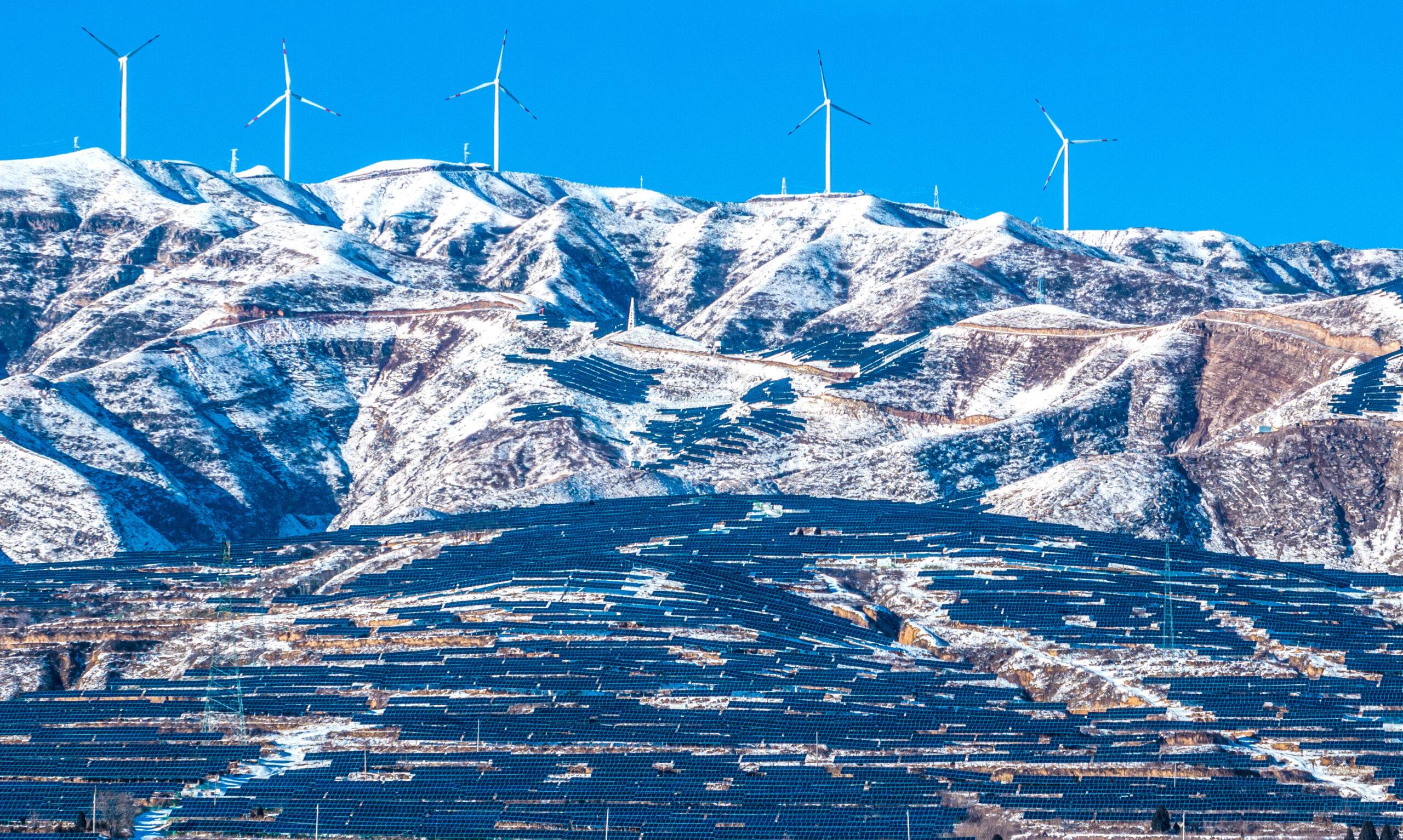
You could make the argument that last year was the worst year in human history for climate change. The Earth experienced its hottest day on record over and over and over again. Air surface temperature anomalies set a record in September. Ocean heat set a record too. The number of wildfires in Canada? Another record high.
But you don’t have to squint too hard to see the good news. U.S. and European carbon emissions have actually declined this century. The rate of global deforestation is going down. And investment in clean energy technology—particularly solar and batteries—is smashing records and changing the world.
Those glimmers of hope come from an epic annual report from Nat Bullard, an independent, Singapore-based climate researcher who spent several years at Bloomberg. In today’s episode, Nat and I discuss the twin pillars of the global clean energy revolution (solar and storage), how these two technologies have consistently beat expert predictions, how they’re reshaping energy generation around the world, and what stands in the way of a clean energy future based around sunshine and batteries.
If you have questions, observations, or ideas for future episodes, email us at PlainEnglish@Spotify.com.
In the following excerpt, Nat Bullard and Derek dive into why solar has taken off so much faster than other energy sources and why even recent projections underestimated solar power.
Derek Thompson: You have published this 200-slide report on the state of the global clean energy revolution, and I feel like it’s really important for us to understand what’s going on in two categories in particular, and that is solar and storage.
I want to make sure that listeners are all on the same page before we dive into the numbers here. I want to start with solar. Can you kick us off with a thesis statement? How would you characterize the speed and strength of solar energy growth? How does it, for example, compare to other energy revolutions, like the growth of nuclear in the second half of the 20th century or liquid natural gas in the last few decades?
Nat Bullard: I think it’s important, if I’m going to start off a thesis statement, [to define] the challenge of thinking about this to begin with, which is that it’s a uniquely distributed technology in a world of generating electrons that has historically been very concentrated. So it’s typically been done and gained its strength over time by building small numbers of successively larger and larger units of something: bigger power plants that are more efficient, bigger infrastructure that has lower costs of units over time.
Solar, on the other hand, is something that is inherently distributed. It works in units as small as a calculator-charging capacity all the way up to deployment in the scale of gigawatts or, eventually, terawatts. So a lot of watts, shall we say, of power, mimicking what the rest of the grid consumes. But it’s manufactured. Instead of being something that’s built custom, that’s built with heavy equipment, it is manufactured in a line very similar in many ways to the way that chips are made or the way that displays are made. And it therefore follows this sort of economics of manufacturing on one side in terms of what gets built, and then it has a sort of abundance behind it in terms of output that tends to find its way into fields faster than people expect.
I like your question about comparing this to the way that new energy carriers have evolved in the last 50 years, the last half century. There’s a comparison that I did early on in my slides, and I’m borrowing a structure, to be clear, very clearly from Shell, from the oil major, which is comparing solar against wind against nuclear and against LNG (liquefied natural gas). And the crazy thing about this, if you’re a long-term energy analyst, you think nuclear, big, established, centralized, LNG, major way of carrying energy, but solar and wind both are faster than nuclear or LNG ever were once they achieved their takeoff in carrying energy. And solar is moving at about twice the speed that wind is, for instance.
So just right now, solar is generating about as much energy seven years after sort of achieving its early liftoff as wind was achieving in around 12 years or nuclear in around 13 years. It’s basically moving twice as fast. And if you look at it on the chart, you see these other sources that have these sort of shapes wherein they achieve a takeoff and then they sort of level out, whereas solar has the beginnings of a curve that is just tilting in a very familiar exponential fashion further up. It’s not only moving, but it’s moving at an accelerating rate.
The trick about all of these things, of course, is that it starts from a small base. So it’s hard to notice this early on industrially, if you don’t pay attention, in capital flows, if you don’t pay attention, and definitely in the grid, wherein these are very sort of nominal additions of new power. But it’s rapidly making its way toward being not that, toward being the bulk of new power that’s going to be added to the grid, definitely the bulk of most of what’s being built on a capacity basis in any given place and definitely globally. And starting to sort of reach what I would call an “end of the beginning” kind of sense. Like at a position where you’re starting to see this achieve a takeoff that has a meaningful, measurable impact on the way that the global power system acts in response.
Thompson: Global solar installations are up 1,000x in the last two decades. That is a point of pride if you are interested in building energy that is clean, that can help us power the world abundantly and not spit up carbon into the atmosphere. It’s also not just a point of pride. To me, it’s a mystery. Global forecasters like IEA, the International Energy Agency, have consistently and famously, perhaps even infamously, whiffed on projections of global deployment of solar energy.
I think I read one statistic of the solar revolution that says we are 90 years ahead of IEA projections from just 2015. Just nine years ago, we whiffed on the deployment of energy by the factor of a century. What is your answer to the question of how did this happen? And don’t give me the tautological answer, like, “We built more by building more.” What, to you, is the root-cause answer to the question of how solar energy growth beat estimates by a century?
Bullard: Institutional failure of imagination on the part of generally linearly minded planners and future forecasters. So you expect the future to look, relatively speaking, like some incremental growth upon the past. This is the way that most things grow, especially when you’re talking about big things, things you expect to sort of reach some sort of asymptotic limit into either how fast they can grow or how big they can get or both.
And especially when you start to think about things that have these sort of inherent limits in them in terms of space and time and construction material and places to lay down your equipment and whatnot, it kind of makes sense. But if you think about something that has a manufacturing logic to it, wherein the capacity to build something [and] increase capacity 5x in a year is really not out of bounds, then it confounds people’s ways of thinking in ways that aren’t particularly helpful, I find.
Another thing is the remit for all of these forecasters was to sort of describe what seems like a defensible vision of the near future, as opposed to a kind of supposition about a further-out period of time. There’s a kind of confusion between the forecast of the projection, which looks at just a couple years, and the scenario, which looks way into the future. And to be fair, for a lot of institutions, they do both of those things. ... So the back-test would tell you you should have probably just put in a logistic curve and let things rip, and you would have gotten a better description of the present day and of the near future than if you had tried to sort of impose constraints.
My old colleagues at BloombergNEF, where I worked for 15 years and was a solar analyst way, way back when, always had this challenge of even them seeing that “I know intimately how this market is right now. I know its constraints. I know the things that make it go or not go in this moment. And therefore I’m going to sort of tweak those incrementally along the future.” Whereas a better way to do it would be to look like, “Wait a minute, there’s no limit on capacity here. Even with solar growing 1,000x in two decades, we could easily do three times more than we did this year based on what we already know is in the pipeline in terms of manufacturing capacity.”
And you have to ask yourself. ... Suspend disbelief would be another thing. Not just failure of imagination, but do you want to suspend your disbelief that this won’t happen and maybe lean more heavily on the side of, “Well, the capacity is there; manufacturers have this interest.” You have to start thinking that maybe we shouldn’t impose limits and sort of impose a sense of growth. Impose a statement that says, “Well, we’ve been able to grow at this rate. If we continue, what’s it going to look like?” As opposed to saying, “Well, surely it’s going to stop at some point.” People want to always impose a law of large numbers. They want to impose a limit, and it’s probably better off not doing that.
This excerpt was edited for clarity. Listen to the rest of the episode here and follow the Plain English feed on Spotify.
Host: Derek Thompson
Guest: Nathaniel Bullard
Producer: Devon Baroldi
Subscribe: Spotify

